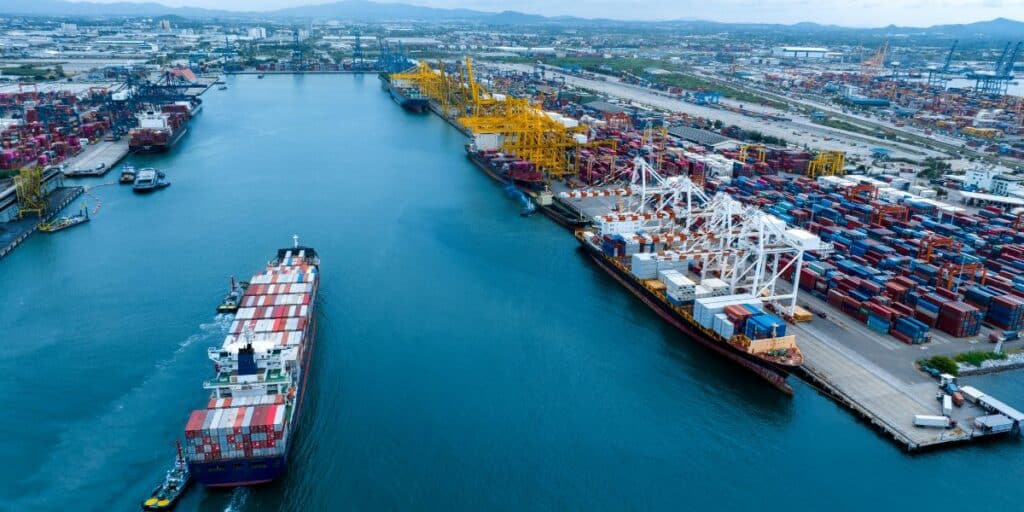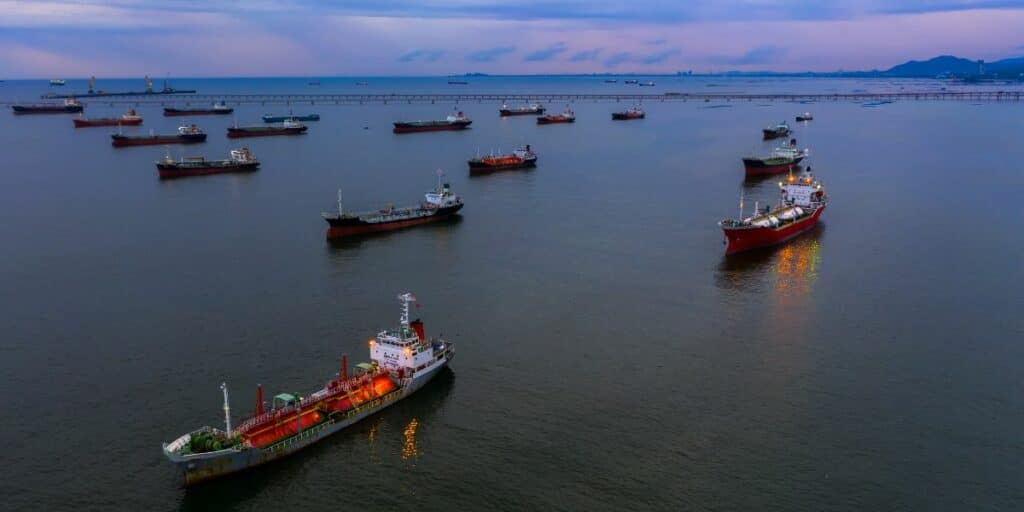The transportation sector stands out as one of the most significant contributors to pollution, with international shipping alone accounting for approximately 3% of the world’s greenhouse gas emissions in 2022. This article provides an in-depth examination of the global shipping industry’s impact on global carbon dioxide (CO₂) emissions and explores the various challenges associated with reducing pollution stemming from oceangoing vessels and their related activities.
What is the carbon footprint of the maritime transportation industry?
In the past few decades, there has been a rapid surge in the release of greenhouse gases (GHG) into the atmosphere, primarily caused by the escalated use of fossil fuels and intensified industrial activities. Although there was a temporary decline in emissions during 2020 as a result of the COVID-19 pandemic’s restrictions, global emissions have since bounced back and hit all-time highs. In 2021, global GHG emissions reached 54.6 billion metric tons of carbon dioxide equivalent (GtCO₂e).
Transportation-related CO₂ emissions worldwide have witnessed remarkable growth, starting at 2.84 billion GtCO₂ in 1970 and escalating to 7.64 billion GtCO₂ by the year 2021, because of the expansion of both global populations and economies. The primary source of these emissions is the combustion of petroleum-based fuels (coal, crude oil, diesel, natural/derived gas, petrol…), predominantly within internal combustion engine vehicles (ICEVs). As of now, the transportation sector contributes a substantial 20.2 percent of the world’s total CO₂ emissions, firmly establishing itself as the second-largest contributor to carbon pollution on a global scale.
Within the transportation sector, shipping claims the third position in terms of carbon dioxide emissions, comprising 11% of the total, trailing closely behind passenger vehicles at 39% and medium to heavy trucks at 23%. Due to the increase in global trade and the demand for maritime carriage of goods, the sector’s carbon footprint, primarily because of CO2, is poised to potentially surge by 50% to 250% by the year 2050 if proactive measures are not taken.
What are the main pollution sources in the maritime transportation sector?

Ships require energy to operate. While cleaner fuels are gradually gaining traction, shipping companies continue to depend on fossil fuels like marine gas oil and heavy fuel oil. The combustion of Heavy Fuel Oil (HFO) results in the release of harmful gases, including carbon dioxide (CO2), methane (CH₄), and nitrous oxide (N₂O), all of which contribute to the problem of climate change. In addition, ships produce sulfur oxide (SOx) emissions, which, although not directly affecting the climate, pose significant environmental and health risks.
The specific emission levels can vary based on multiple factors, including the size and type of ships, their dead weight capacity, energy efficiency, the type of fuel used, and the distances they cover on an annual basis.
As an illustration, cargo ships are reported to produce 16.14 grams of CO2 per kilometer for each metric ton of cargo they carry. Yet, while container ships release an annual average of 140 million metric tons of carbon dioxide, bulk carriers contribute a total of 440 million metric tons of carbon dioxide emissions each year.
A benchmark created by CarbonChain, the carbon accounting platform for the world’s supply chains, provides an overview of cargo ships’ AER* (Annual Efficiency Ratio) depending on their dead weight capacity:
- Less than 5,000 gross tonnage: 15.4 gCO2/dwt.nm
- From 5,000 to 9,999 gross tonnage: 14.7 gCO2/dwt.nm
- As from 10,000 gross tonnage: 11.2 gCO2/dwt.nm
*The AER quantifies a ship’s carbon dioxide emissions per unit of nominal transport work. This metric is calculated as the product of a ship’s dead weight capacity and the total distance it travels in nautical miles, expressed as grams of CO2 per deadweight ton per nautical mile (gCO2/dwt.nm).

What are the environmental initiatives to lower the GHG emissions in shipping?
Recognizing the imperative to mitigate the environmental impact of freight transportation by sea, the International Maritime Organization (IMO) has revised its sights on achieving net-zero emissions for the sector by around 2050. As a recall, it initially set a target to cut emissions by 40% in 2030 and 70% in 2050 compared to the levels recorded in 2008.
To reach this ambitious goal, member nations have agreed on “benchmark milestones”: a 20% reduction by 2030 (with a goal of 30%) and a 70% reduction by 2040 (with a goal of 80%).
The IMO’s GHG strategy, which was set to enhance the sustainability of the industry, encompasses a range of initiatives:
- Harness renewable energy sources to power oceangoing vessels: wind power, including sails and rotor sails, can assist in propulsion, while the installation of solar panels on ships can generate clean electricity.
- Switch from traditional marine fuels to cleaner alternatives that emit fewer pollutants and greenhouse gases: This includes options such as liquefied natural gas (LNG), hydrogen, and biofuels like methanol and ammonia. Battery-electric or hybrid systems can be used for energy storage, especially on short sea routes. Additionally, hydrogen fuel cells can be employed for electric propulsion.
- Promote the development of more energy-efficient vessels by optimizing their design and equipment. This involves modifying hull shapes to enhance propulsion efficiency and reduce energy consumption. Applying specialized hull coatings can decrease friction and improve fuel efficiency. Upgrading engines to more energy-efficient models is also crucial.
- Utilizing slow steaming to reduce the speed of cargo ships compared to their maximum capabilities enables the reduction of fuel consumption and greenhouse gas emissions.
- Leverage technological innovations to enhance fuel efficiency: Employ data analytics to optimize ship routes, speeds, and operations. Install advanced onboard systems for improved energy management.
- Provide shore power at ports to enable ships to turn off their engines while docked, thus reducing emissions.
- Implement supportive policy measures to facilitate the transition toward eco-friendly practices: Encourage companies and organizations to invest in carbon offset projects as a means to compensate for their emissions. Governments can provide financial incentives such as subsidies or tax incentives to companies adopting cleaner technologies and fuels. Additionally, pricing carbon emissions can incentivize emissions reductions.

- Minimize the use of empty containers and work toward consolidating and optimizing cargo loads for increased efficiency.
- Train seafarers and shipping professionals in sustainable practices and eco-friendly technologies.
- Enforce regulations: The International Maritime Organization (IMO) has initiated programs like the Energy Efficiency Existing Ship Index (EEXI) and the Carbon Intensity Indicator (CII) to enhance vessel efficiency. The creation of Emission Control Areas (ECAs), designated areas with stricter emissions standards, can encourage the use of cleaner fuels and technologies.
- Strengthen collaboration and cooperation across the entire value chain to share knowledge, and best practices, and foster sustainable innovations. This can be achieved through industry collaborations, government partnerships, and international agreements.
Beyond 2035, we will see the full impact of gradually improving the energy efficiency of new ships, and of the shift to carbon-neutral fuels for the pathways to achieve IMO ambitions.
What are the new regulations implemented to reduce shipping emissions?
Starting in January 2023, the International Maritime Organization has introduced a series of new mandatory measures, amending MARPOL Annex VI Regulations. These were adopted in July 2011 by the Marine Environment Protection Committee (MEPC) to reduce GHG emissions from international shipping.
- Ships constructed on or after January 1, 2013, must employ the Energy Efficiency Design Index (EEDI) to assess and improve their emission intensity. They are also obligated to report their Carbon Intensity Indicator (CII).
- For existing vessels, there is a requirement to record their energy usage by implementing the Ship Energy Efficiency Management Plan (SEEMP), which is integrated into their comprehensive management plan.

How are carbon emissions in maritime transport quantified?
Every company operating within the sector has to keep an eye on its CO2 emissions. This imperative extends beyond concerns about environmental harm, it also affects businesses. First, sustainability has become a priority for consumers when making choices among brands. Additionally, considering the escalating costs, especially in fuel, embracing well-thought-out sustainable initiatives can significantly enhance their profitability, both in the present and in the long term. Lastly, it helps companies get ahead of new regulations.
The first step of the process is mapping emissions throughout the supply chain. This helps establish quantifiable targets for decarbonization, pinpoint opportunities for reduction, select suitable low-carbon alternatives to implement, and track progress.
The Clean Cargo Working Group (CCWG) has developed a standard methodology for emissions accounting and benchmarking in the ocean shipping sector. A container vessel uses the volume of Fuel consumed, the total distance sailed, and the maximum capacity in 20-foot equivalent container units (TEUs).
As calculation methods of carbon emissions might be quite complicated for non-specialists, they can rely on dedicated software like Sinay’s CO2 Emissions Calculator API to track the carbon emissions associated with ocean freight. This tool offers the capability to estimate emissions for upcoming sea voyages or calculate them after the voyage has been completed.
Furthermore, the IMO is actively working on implementing a global sulfur cap on marine fuels as part of its efforts to reduce emissions stemming from the shipping sector. For example, the organization has established the Mediterranean Sea Emission Control Area (ECA) to regulate sulfur oxides and particulate matter emissions. This decision was made in December 2022, with the Mediterranean supporting 20% of seaborne trade with several busy maritime routes.
Besides, the European Parliament has endorsed changes to the EU ETS, extending its coverage to include all maritime emissions. This expansion applies to ships exceeding 5,000 gross tonnage operating within the European Economic Area (EEA). As a result, every company with vessels engaged in EEA trade must submit emission allowances equivalent to a portion of their greenhouse gas (GHG) emissions during a given calendar year.
Conclusion
Decarbonizing the maritime shipping industry is a complex and multifaceted challenge, requiring concerted efforts by ship operators, governments, international organizations, and technology innovators. The industry is making progress toward a more sustainable future, driven by a combination of regulatory pressure, market forces, and environmental consciousness.
Frequently Asked Questions about Shipping Industry and Carbon Emissions
The maritime transportation industry contributes significantly to global carbon dioxide (CO₂) emissions.
In 2022, international shipping alone accounted for nearly 3% of the world’s greenhouse gas emissions. The transportation sector, including shipping, is responsible for about 20.2% of the world’s total CO₂ emissions, making it the second-largest contributor to global carbon pollution.
The maritime transportation sector primarily relies on fossil fuels like marine gas oil and heavy fuel oil (HFO). The combustion of HFO releases harmful gases, including carbon dioxide (CO2), methane (CH₄), and nitrous oxide (N₂O), contributing to climate change. Ships also produce sulfur oxide (SOx) emissions, posing environmental and health risks.
Emission levels vary based on ship size, fuel type, energy efficiency, and distances traveled.
Global trade and maritime shipping are expected to continue growing significantly. The OECD forecasts a tripling of global freight demand by 2050, with seaborne trade potentially exceeding 120,000 billion tonne-miles.
However, the types of commodities transported may shift, with a decrease in fossil fuel shipments and an increase in raw materials and finished products.
To reduce greenhouse gas (GHG) emissions from shipping, the International Maritime Organization (IMO) has set ambitious targets, including achieving net-zero emissions by around 2050.
Initiatives include harnessing renewable energy, switching to cleaner fuels like LNG and hydrogen, optimizing ship design for efficiency, implementing slow steaming, using technology for route optimization, and enforcing regulations like the Energy Efficiency Existing Ship Index (EEXI) and Carbon Intensity Indicator (CII). Collaboration across the industry is also encouraged.
Focus on data to make effective decisions
Discover our modules
Environmental Monitoring
Monitor air quality in real-time, be alerted when a threshold is reached & easily comply with regulation thanks to the automated reports.
Monitor water quality in real-time, predict and avoid water pollution & comply with regulations thanks to the automated reports.
Deliver a preliminary metocean analysis and the associated report in jut a few minutes.
You may also be interested by those others environment application :





